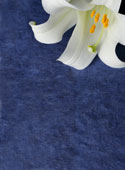Please Eat the Easter Lilies
“Consider the lilies of the field” – New Testament
Last Saturday, I purchased an Easter Lily (also known as the White Trumpet Lily or Bermuda Lily) for my mother and noticed that the checkout slip read simply “Asiatic Lily”. Grown by the thousands in Oregon, this simple white Asiatic lily has origins in Bermuda via Japan and has become a symbol for faith and hope at Easter.
The register slip made me curious however about the differences between Asiatics and Orientals and whether or not all lilies can be eaten, so I decided to look it up once and for all.
Here’s what I found:
The Difference Between Asiatic Lilies and Oriental Lilies
Essentially, there is little difference – both lilies are grown from bulbs.
Scented: The Asiatics are scent-free while the Orientals are scented, something to remember if you have scent allergies.
Blooming Season: Asiatics like the white Easter Lily, bloom in the spring; Orientals bloom in the fall.
Are day lilies edible? Which part can you eat?
Here’s what Farmer’s Almanac has to say:
Almost every part of the lily is suitable for eating. It goes well with pork and soy sauce, a nod to its Chinese heritage. You can eat the green buds of day lilies.
As to taste, here’s a post on iVillage GardenWeb:
Culinary Uses: The young green leaves are edible raw or cooked. Older leaves become fibrous. Tubers are also edible raw or cooked and have a nutty flavour. Young tubers are best, though the central portion of older tubers is also good. Steam or boil the tubers as a potato substitute, or toss them raw onto a salad instead of croutons. The flowers can be eaten raw or cooked. The petals are thick and crunchy, making very pleasant eating raw, with a nice sweetness at the base because of the nectar. They taste somewhat like fresh peas.
They can be fried for storage and used as a thickener in soups and stews, or used as a relish. Leaves and young shoots can be cooked and used as a substitute for asparagus or celery. Take small shoots under 15cm, strip away the larger leaves, saute in a little garlic and oil, add raw to salads, or simply steam and drench in butter for a nice, crunchy treat.
Here’s a recipe: boil a few day lily buds and add them to herb butter. Make herb butter with 1/2 cup creamed butter, 1/2 tablespoon finely chopped parsley and 1/1/2 tablespoons of chopped savory. Add lemon juice and seasonings to taste. You can eat the tubers of lilies all summer, even after the blooms have gone away. Eat them like radishes or chopped into salads.
 Cautions: The leaves of some lilies are toxic to cats and can cause harm if they eat a lot.
Cautions: The leaves of some lilies are toxic to cats and can cause harm if they eat a lot.
Similarly, eating too many leaves can cause hallucinations in humans and eating too many flowers can act as a diuretic and/or laxative.
Here are a few more recipes from iVillage Garden Web, oriental style of course:
Day Lily Bud Saute
2 dozen day lily buds, white bases removed
1/2 cup flour
1/4 cup olive oil
3 eggs
pinch of nutmeg
salt and pepper
I clove garlic, finely chopped
Saute the garlic in a little olive oil. Beat eggs, mix in enough flour to make a thin batter. Add the garlic, salt and pepper, and nutmeg. Add a teaspoon of milk if the batter is too thick. Dip the buds in the batter and saute until golden brown.
Daylily flowers can be stuffed, or added to soups and vegetables dishes. They can be boiled, steamed or added to stirfries. Add them to salads, or coat with batter and fry. Daylily leaves taste a little like creamed onions. Choose young leaves for best flavour. Add to soups, vegetable dishes and stirfries.
Day Lily Pork
3/4 cup onion rings
3 tablepsoons butter
1 clove garlic, mashed
8 thin slices of pork
1 tablespoon cornflour
2 tablespoons soy sauce
1/4 teaspoon powdered ginger
1 tablespoon Madeira wine
salt and pepper to taste
1 1/2 cups chopped day lilies
Saute onions in the butter until translucent. Remove onions from pan with a slotted spoon and set aside. To butter, add garlic and pork slices. Cook both sides of pork, and remove from pan, leaving the juices and butter within the pan. Stir cornflour into the soy sauce until smooth, add to the pan with ginger, wine, salt andpepper. Stir ingredients until thickened and clear. Add the chopped day lily and onions to the pan and stir 2 minutes over medium heat. Pour this mixture over pork and serve.
Pasta with Day Lily Buds and Mushrooms
about 185g oyster or shiitake mushrooms
1 heaped cup daylily buds, 2-3cm long
2 tablespoons unsalted butter
2 tablespoons olive oil
2 shallots, finely minced
1/2 teaspoon freshly chopped marjoram
1 tablespoon fresh chopped parsley
salt and pepper to taste
freshly grated parmesan cheese
500g fresh fettucinne noodles
Put water on to boil while preparing vegetables. Tear mushrooms into large bite size pieces and remove stem of shiitakes. Rinse the daylily buds and pat dry. In large frypan, heat butter and oil over medium heat. Add the shallots and saute them about 1 minute. Add mushrooms and stir for 1-2 minutes. Add daylily buds and stir 2-3 minutes. Add the herbs and season to taste with salt and pepper. Cover the pan and let stand over low heat for a few minutes while pasta is cooking. Drain the pasta, add it to the vegetables, and toss well. Add another tablespoon of butter or oil if necessary. Taste for seasoning and serve hot. Garnish with bread crumbs and parmesan if desired.
Spiced Pickled Day Lily Buds
2 litres day lily buds, freshly boiled and drained
3 cups white vinegar
3/4 cup brown sugar, packed
1/2 teaspoon salt
1/2 teaspoon whole allspice
2 sticks cinnamon, 5cm long, broken up
10-12 whole cloves
Rinse and drain unopened day lily buds; clip off any stem remnants. Put buds in a saucepan, add water barely to cover. Bring quickly to the boil, cover, and simmer 20 minutes. Drain. (At this point, the buds can also be served as a vegetable dish after adding salt, pepper, spices, etc. Or they can be stuffed with ricotta cheese and served.
Pack hot buds into 8 sterile 400ml preserving jars. Combine vinegar, brown sugar, salt, allspice, cinnamon, and cloves in a saucepan and bring to the boil. Boil 3 minutes. Pour pickling solution over buds, distributing spices equally. Seal at once. Leave for a few weeks before using.
Finally, the Easter Lily can be planted outdoors (about 3″ of soil above top of bulb) and will survive the winter if mulched well. It likes its head in the sun and its feet in the shade@
Posted on April 13, 2009, in Food Gardening, Wild Food and tagged Easter Lilies, edible lilies. Bookmark the permalink. 1 Comment.
Reblogged this on Bobbi's Blog.